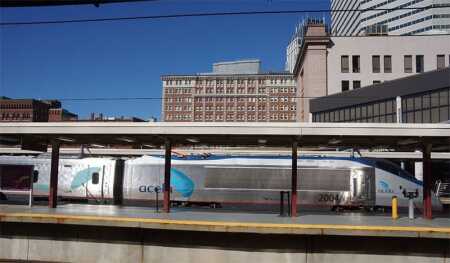
An Acela train at Boston’s South Station. The proposed $2.1 billion North-South Rail Link project would construct a pair of rail tunnels, each about 1.5 miles (2.4 km) long, that would not only connect North Station and South Station, but also improve efficiency, mobility, and capacity throughout Massachusetts, New England, and the Northeast Corridor, according to its proponents.
In the last decade, Boston and neighboring Cambridge have emerged as magnets for tech and life science companies seeking to tap into the highly educated talent pool drawn to the area by its universities, medical institutions, and quality of life. But a lack of access to those job centers and a dearth of affordable housing threaten to impede Greater Boston’s competitive positioning and stymie future growth.
ULI Advisory Services was asked to examine how the construction of an underground rail line linking North Station to South Station in downtown Boston could help alleviate Greater Boston’s transportation and housing woes, potentially unlocking the development potential of select sites within the city. Comprising nationally renowned land use and urban planning experts, the panel convened in Boston for nearly a week before offering its recommendations in a public meeting held in early October at the Boston Park Plaza Hotel.
The contingent was led by Marilee Utter, president of Citiventure Associates in Denver and chairwoman of the advisory panel, who described the undertaking as a “TAP on steroids,” in reference to the one-day Technical Assistance Program panels (TAPs) conducted by ULI district councils that help local communities resolve land use challenges.
Utter was joined by Rick Krochalis, commissioner of the Seattle Design Commission; Robert Ravelli, director at Contemporary Solutions in London; Michael Reynolds, principal of the Newport Beach, California–based Concord Group; Stan Wall, partner with HR&A Advisors, Washington, D.C.; Theresa Ward, deputy county executive/commissioner, Suffolk County Department of Economic Development and Planning in Hauppauge, New York; Mary Campbell, associate vice chancellor for real estate at Washington University, St. Louis, Missouri; and Stephen Whitehouse, partner at Starr Whitehouse Landscape Architects and Planners of New York City.
The event was sponsored by the Massachusetts Competitive Partnership in collaboration with the city of Boston and several communities in the Boston region, at the urging of U.S. Representative Seth Moulton (D-Mass.), who has been championing the development of the North-South Rail Link (NSRL) since he began serving in Congress in 2015. The project had been proposed over a century ago by the city of Boston and the commonwealth of Massachusetts and discussions were revived intermittently through the years, but the current conditions in the region have a spurred a new sense of urgency to come up with solutions.
The proposed $2.1 billion NSRL project would construct a pair of rail tunnels, each about 1.5 miles (2.4 km) long, that would not only connect North Station and South Station, but also improve efficiency, mobility, and capacity throughout Massachusetts, New England, and the Northeast Corridor, according to its proponents. The city is currently served by two commuter rail systems—one extending to the north of the city, the other to the south—but they are not connected, and neither is fully linked to the existing subway system. Completion of the connection would not only improve commute times into and within the city, but also create further TOD opportunities along the commuter rail, particularly in the region’s struggling gateway cities.
Reynolds provided background for the presentation, referring to Greater Boston as the “envy of the nation,” citing the state’s fourth-highest gross domestic product (GDP) per capita, the number-two ranking in venture capital investment, and a Boston office vacancy rate of 6.8 percent (compared with the national average of 13 percent). The population in Boston has been growing at an annual rate of 1.3 percent—double the national rate—and has one of the country’s highest percentages of the coveted millennial workforce. But given the housing and transportation issues, growth for the region is not sustainable.
Boston is plagued by some of the highest housing prices (rent for a two-bedroom unit in Boston/Cambridge averages $3,050 per month, and the average home price is $553,000) in the nation, and is heavily automobile dependent, with the third-worst traffic congestion in the United States. The state’s transportation system (the MBTA) is antiquated, operating at capacity and prone to frequent delays, and the commuter rail is slow and underused, operating at capacity only during peak times.
Reynolds says that the region’s competitive positioning among U.S. cities is in jeopardy. “If you want to continue to grow as much as we have over the last five or six years, we’re going to need over 300,000 to 400,000 housing units over the next 30 years—10,000 to 13,000 units per year,” he said. “Simply put, the continued prosperity of this region really depends upon an efficient and improved transportation system that links housing to jobs.”
The panel was also asked to evaluate the real estate impact of the NSRL on five “catalytic” sites in the downtown area, including North Station, Central Station, the South Station/United States Postal Service (USPS), Fort Point Station, and Widett Circle. It was determined that completion of the NSRL could potentially create $8 billion in mixed-use development at Widett Circle, while also alleviating the extent of the proposed South Station expansion, which would allow for more of the USPS site to be made available for mixed-use development.
“From our analysis, we have concluded that the NSRL will have a positive future real estate impact by mitigating loss of at-risk downtown sites to infrastructure, and more importantly, by facilitating regional economic development,” said Wall. “The key to note, though, is that the link by itself won’t result in these impacts. It needs to be done as part of a coordinated prioritized investment across the entire rail system.”
A more detailed report of the panel’s findings and recommendations will be issued soon.





